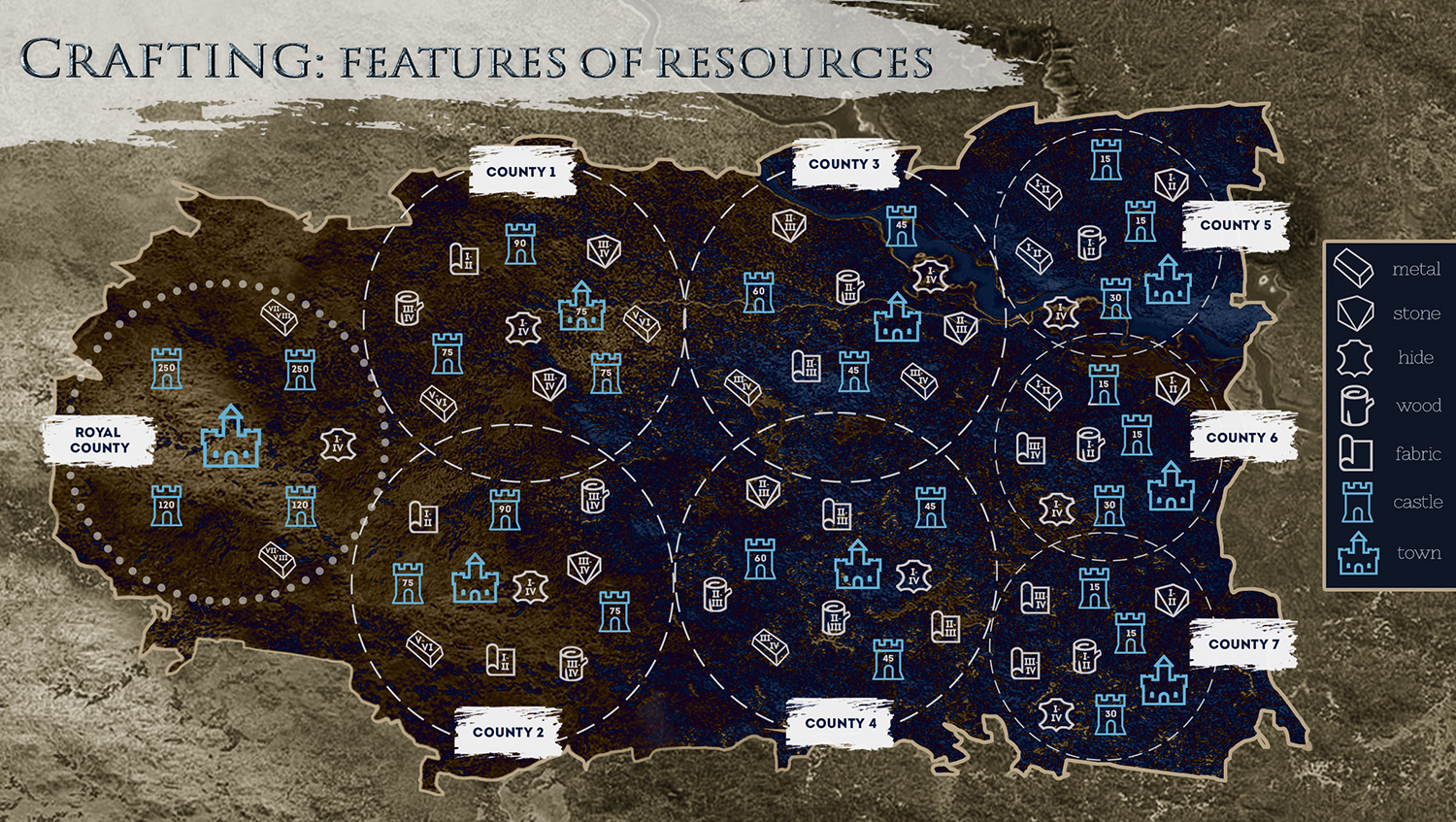
In the first article about the system of crafting in the Reign of Guilds, we described types of resources and where they are extracted and processed. Today we will tell you more about the features of each type of resources.
- Metals and alloys
The process of metal and alloy production begins in the mines, where a player can find one of 8 types of ore. In any county, there are 1-2 mines with 2 different types of ore in each one.
Each type of ore has a predominant metal obtained by remelting this ore. This means that 8 types of ore can give 8 types of metals.
In addition, there are 8 types of rare metals that are randomly generated at remelting the ore. Thus, a total of 16 types of metals can be produced in the game world.
You will need not only pure metals, but also alloys for crafting. Alloys are produced by mixing 2-3 types of metals in a certain proportion. There will be a total of 18 types of alloys in the game.
Besides ore types, there is an ore purity parameter. It determines the amount of metal produced at processing this ore. The metal purity is generated randomly at different mines and changes over time.
The price for remelting is fixed and calculated on the basis of the weight (1 kilogram) of any type of ore. But at the insufficient funding of remelting, all rare metals will go to an NPC trader. You will have to pay an additional price to get the metals from a merchant.
- Wood
Wood can be produced in the picturesque forests of the RoG world, on the plots intended for this purpose.
Just like with mines, there are 1-2 plots in each county where 2 different types of logs are mined. 4 types of logs will be used at crafting.
Logs are processed at sawmills, as a result a player gets wood.
Besides types of logs, there is a Wood Moisture Content parameter. It determines the amount of produced wood. Wood Moisture Content depends on the season and changes periodically.
- Stone blocks
Stone blocks are produced from stones, which are processed at the bricklayer's workshop. In total, there are 4 types of stones.
Stones are mined in the quarries, located near bricklayers’ workshops. In each county, there are 1-2 quarries with 2 different types of stones in each one.
Stones have a stone shape parameter that determines the number of stone blocks produced at processing this stone. The stone shape depends on the season and changes periodically.
- Fabric
Fabric is made from fiber at the weaving workshop. In total, there are 4 types of fiber with 4 types of fabric produced from them.
The fiber is produced at the plantations, there are... right - 1-2 plantations in each county. Each plantation has 2 different types of fiber.
The fiber length parameter determines the amount of produced fabric. The fiber length depends on the season and changes periodically.
- Leather
Leather is produced by processing hide at the leather workshop. There are 4 types of leather corresponding to 4 types of Hide in the game. Hide is obtained by killing animal mobs.
Hide have their own parameter - the hide quality. It affects the amount of leather produced at processing the skin. Hide quality is generated randomly when killing a mob.
The hide processing price is fixed per kilogram, but at insufficient funding a part of the resulting materials goes to an NPC trader. You will have to pay him to get your materials back.
- Minerals
Unlike the above-mentioned resources, minerals are randomly scattered around mines and mountain ranges. In total, there are 12 types of minerals in the game world. There is no need to process them, so you can use minerals immediately after finding them...
- Herbs
Those, who love collecting virtual herbaria, will not be disappointed as the game world provides 14 sorts of herbs, one species per attribute.
Herbs, like minerals, are randomly scattered around the world, but grow at a distance from mines and mountain ranges.
- Spare parts
Spare parts are everything that falls out from mobs, but not included in the equipment category.
Spare parts have a value parameter - depending on the mob level, corresponding spare parts fall from it. Ordinary spare parts fall out from ordinary mobs, medium ones - from nominal mobs, valuable ones - from raid mobs and exceptional spare parts fall out from event mobs.
And, of course, we will not let you go without a clear illustration of the location of resources in the open world:

This symbolic map presents the resource allocation rules described above.
Our team has developed a complex system where each resource has many features, its own significance and value.
We believe that such comprehensive system of resource usage will additionally stimulate the in-game economy and most importantly – raise the interest of players to study this aspect in the game.
Author: Grigoriy Lysov
Editor: Maksim Dvornikov, Yulia Sigaeva